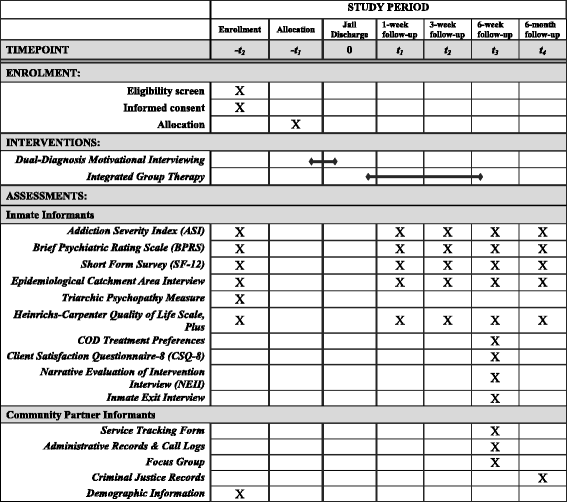Jail-to-community treatment continuum for adults with co-occurring substance use and mental disorders: study protocol for a pilot randomized controlled trial
- PMID: 28778175
- PMCID: PMC5545037
- DOI: 10.1186/s13063-017-2088-z
Jail-to-community treatment continuum for adults with co-occurring substance use and mental disorders: study protocol for a pilot randomized controlled trial
Abstract
Background: Adults with co-occurring mental and substance use disorders (CODs) are overrepresented in jails. In-custody barriers to treatment, including a lack of evidence-based treatment options and the often short periods of incarceration, and limited communication between jails and community-based treatment agencies that can hinder immediate enrollment into community care once released have contributed to a cycle of limited treatment engagement, unaddressed criminogenic risks, and (re)arrest among this vulnerable and high-risk population. This paper describes a study that will develop research and communication protocols and adapt two evidence-based treatments, dual-diagnosis motivational interviewing (DDMI) and integrated group therapy (IGT), for delivery to adults with CODs across a jail-to-community treatment continuum.
Methods/design: Adaptations to DDMI and IGT were guided by the Risk-Need-Responsivity model and the National Institute of Corrections' implementation competencies; the development of the implementation framework and communication protocols were guided by the Evidence-Based Interagency Implementation Model for community corrections and the Inter-organizational Relationship model, respectively. Implementation and evaluation of the protocols and adapted interventions will occur via an open trial and a pilot randomized trial. The clinical intervention consists of two in-jail DDMI sessions and 12 in-community IGT sessions. Twelve adults with CODs and four clinicians will participate in the open trial to evaluate the acceptability and feasibility of, and fidelity to, the interventions and research and communication protocols. The pilot controlled trial will be conducted with 60 inmates who will be randomized to either DDMI-IGT or treatment as usual. A baseline assessment will be conducted in jail, and four community-based assessments will be conducted during a 6-month follow-up period. Implementation, clinical, public health, and treatment preference outcomes will be evaluated.
Discussion: Findings have the potential to improve both jail- and community-based treatment services for adults with CODs as well as inform methods for conducting rigorous pilot implementation and evaluation research in correctional settings and as inmates re-enter the community. Findings will contribute to a growing area of work focused on interrupting the cycle of limited treatment engagement, unaddressed criminogenic risks, and (re)arrest among adults with CODs.
Trial registration: ClinicalTrials.gov, NCT02214667 . Registered on 10 August 2014.
Keywords: Jail; Mental illness; Open trial; Randomized controlled trial; Substance use.
Conflict of interest statement
Ethics approval and consent to participate
All study protocols were reviewed and approved by the Institutional Review Boards at RTI International (IRB ID 13531) and North Carolina State University (study 5678).
Consent for publication
Not applicable.
Competing interests
The authors declare that they have no competing interests.
Publisher’s Note
Springer Nature remains neutral with regard to jurisdictional claims in published maps and institutional affiliations.
Figures
References
-
- Drake RE, Brunette MF. Complications of severe mental illness related to alcohol and drug use disorders. In: Galanter M, editor. Recent developments in alcoholism. New York: Plenum Publishing; 1998. pp. 285–99. - PubMed
Publication types
MeSH terms
Associated data
Grants and funding
LinkOut - more resources
Full Text Sources
Other Literature Sources
Medical



